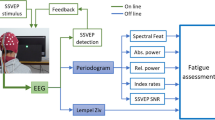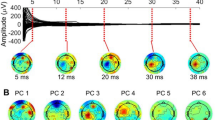Abstract
3D movies are attracting the viewers as they can see the objects flying out of the screen. However, many viewers have reported various problems which are usually faced after watching 3D movies. These problems include visual fatigue, eye strain, headaches, dizziness, blurred vision or collectively may be termed as visually induced motion sickness (VIMS). This research focuses on the comparison between 3D passive technology with a conventional 2D technology to find that whether 3D is causing trouble in the viewers or not. For this purpose, an experiment was designed in which participants were randomly assigned to watch 2D or a 3D movie. The movie was specially designed to induce VIMS. The movie was shown for the duration of 10 min to every participant. The electroencephalogram (EEG) data was recorded throughout the session. At the end of the session, participants rated their feelings using simulator sickness questionnaire (SSQ). The SSQ data was analyzed and the ratings of 2D and 3D participants were compared statistically by using a two tailed t test. From the SSQ results, it was found that participants watching 3D movies reported significantly higher symptoms of VIMS (p value <0.05). EEG data was analyzed by using MATLAB and topographic plots are created from the data. A significant difference has been observed in the frontal-theta power which increases with the passage of time in 2D condition while decreases with time in 3D condition. Also, a decrease in beta power has been found in the temporal lobe of 3D group. Therefore, it is concluded that there are negative effects of 3D movies causing significant changes in the brain activity in terms of band powers. This condition leads to produce symptoms of VIMS in the viewers.





Similar content being viewed by others
References
Lambooij M, Fortuin M, Heynderickx I, IJsselsteijn W (2009) Visual discomfort and visual fatigue of stereoscopic displays: a review. J Imaging Sci Technol 53:030201
Yano S, Ide S, Mitsuhashi T, Thwaites H (2002) A study of visual fatigue and visual comfort for 3D HDTV/HDTV images. Displays 23:191–201
Daugherty BC, Duchowski AT, House DH, Ramasamy C (2010) Measuring vergence over stereoscopic video with a remote eye tracker. In: Proceedings of the 2010 symposium on eye-tracking research applications, Austin, Texas, pp. 97–100
Lee Eui Chul, Heo Hwan, Park Kang Ryoung (2010) The comparative measurements of eyestrain caused by 2D and 3D displays. Consum Electron IEEE Trans 56(3):1677–1683
Lubeck AJA et al (2015) Motion in images is essential to cause motion sickness symptoms, but not to increase postural sway. Displays 38:55–61
Hoffman David M, Girshick Ahna R, Akeley Kurt, Banks Martin S (2008) Vergence-accommodation conflicts hinder visual performance and cause visual fatigue. J Vis 8(3):33
Sugita N, Yoshizawa M, Tanaka A, Abe K, Yambe T, Nitta S, Chiba S (2004) Evaluation of the effect of visually-induced motion sickness based on pulse transmission time and heart rate. In SICE 2004 annual conference, vol. 3, pp. 2473–2476
Abe M, Yoshizawa M, Sugita N, Tanaka A, Chiba S, Yambe T, Nitta SI et al. (2006) Physiological evaluation of effects of visually-induced motion sickness using finger photoplethysmography. In SICE-ICASE, 2006. International Joint Conference, pp. 2340–2343
Naqvi SAA, Badruddin N, Malik AS, Hazabbah W, Abdullah B (2013) Does 3D produce more symptoms of visually induced motion sickness?. In Engineering in Medicine and Biology Society (EMBC), 2013 35th annual international conference of the IEEE, pp. 6405-6408
Reason JT, Brand JJ (1975) Motion sickness. Academic Press, New York
Chen YC, Duann JR, Chuang SW, Lin CL, Ko LW, Jung TP, Lin CT (2010) Spatial and temporal EEG dynamics of motion sickness. NeuroImage. 49:2862–2870
Kim YY, Kim HJ, Kim EN, Ko HD, Kim HT (2005) Characteristic changes in the physiological components of cybersickness. Psychophysiology 42:616–625
Min BC, Chung SC, Min YK, Sakamoto K (2004) Psychophysiological evaluation of simulator sickness evoked by a graphic simulator. Appl Ergon 35:549–556
Hu S, McChesney KA, Player KA, Bahl AM, Buchanan JB, Scozzafava JE et al (1999) Systematic investigation of physiological correlates of motion sickness induced by viewing an optokinetic rotating drum. Aviat Space Environ Med. 70:759–765
Kennedy RS, Lane NE, Berbaum KS, Lilienthal MG (1993) Simulator sickness questionnaire: an enhanced method for quantifying simulator sickness. Int J Aviat Psychol 3:203–220
Dupont WD, Plummer WD Jr (1990) Power and sample size calculations: a review and computer program. Control Clin Trials 11:116–128
McCauley M E (1984) Research issues in simulator sickness: Proceedings of a Workshop. National Academy Press, Washington, D.C
Solimini AG, La Torre G, Mannocci A, Di Thiene D, Boccia A (2010) Prevalence of symptoms of visually induced motion sickness and visual stress during and after viewing a 3D movie. Eur J Public Health 20:242
Ujike H, Yokoi T, Saida S, (2004) Effects of virtual body motion on visually-induced motion sickness. Engineering in Medicine and Biology Society, 2004. IEMBS ‘04. 26th Annual International Conference of the IEEE, vol. 1, pp. 2399–2402, 1–5 Sept 2004
Ujike H, Watanabe H (2011) Effects of stereoscopic presentation on visually induced motion sickness. In: Proceedings of SPIE—The International Society for Optical Engineering, San Francisco, California, USA, pp. 786314–786316
Gratton G, Coles MGH, Donchin E (1983) A new method for off-line removal of ocular artifact. Electroencephalogr Clin Neurophysiol 55:468–484
Chelen WE, Kabrisky M, Rogers SK (1993) Spectral analysis of the electroencephalographic response to motion sickness. Aviat Space Environ Med 64:24–29
Wu JP (1992) EEG changes in man during motion-sickness induced by parallel swing. Space Med Med Eng 5:200–205
Wood CD, Stewart JJ, Wood MJ, Struve FA, Straumanis JJ, Mims ME, Patrick GY et al (1994) Habituation and motion sickness. J Clin Pharmacol 34:628–634
Jatoi MA, Kamel N, Malik AS, Faye I, Begum T (2014) A survey of methods used for source localization using EEG signals. Biomed Signal Process Control 11:42–52
Jatoi MA, Kamel N, Malik A, Faye I (2014) EEG based brain source localization comparison of sLORETA and eLORETA. Australas Phys Eng Sci Med 37:713–721
Acknowledgments
This research is supported by the Universiti Teknologi PETRONAS Short-Term Internal Fund (STIRF) 13/2011.
Author information
Authors and Affiliations
Rights and permissions
About this article
Cite this article
Naqvi, S.A.A., Badruddin, N., Jatoi, M.A. et al. EEG based time and frequency dynamics analysis of visually induced motion sickness (VIMS). Australas Phys Eng Sci Med 38, 721–729 (2015). https://doi.org/10.1007/s13246-015-0379-9
Received:
Accepted:
Published:
Issue Date:
DOI: https://doi.org/10.1007/s13246-015-0379-9




